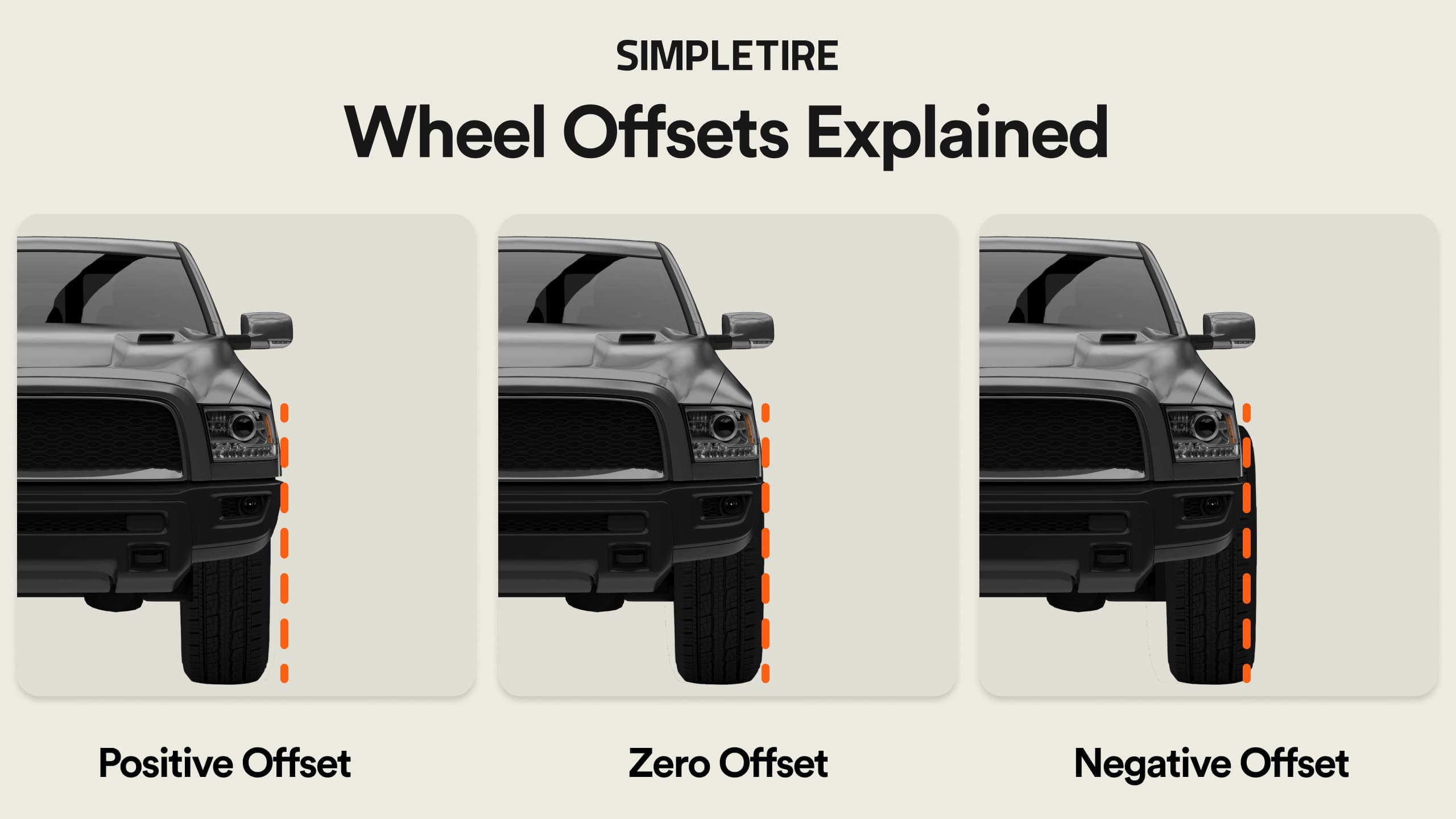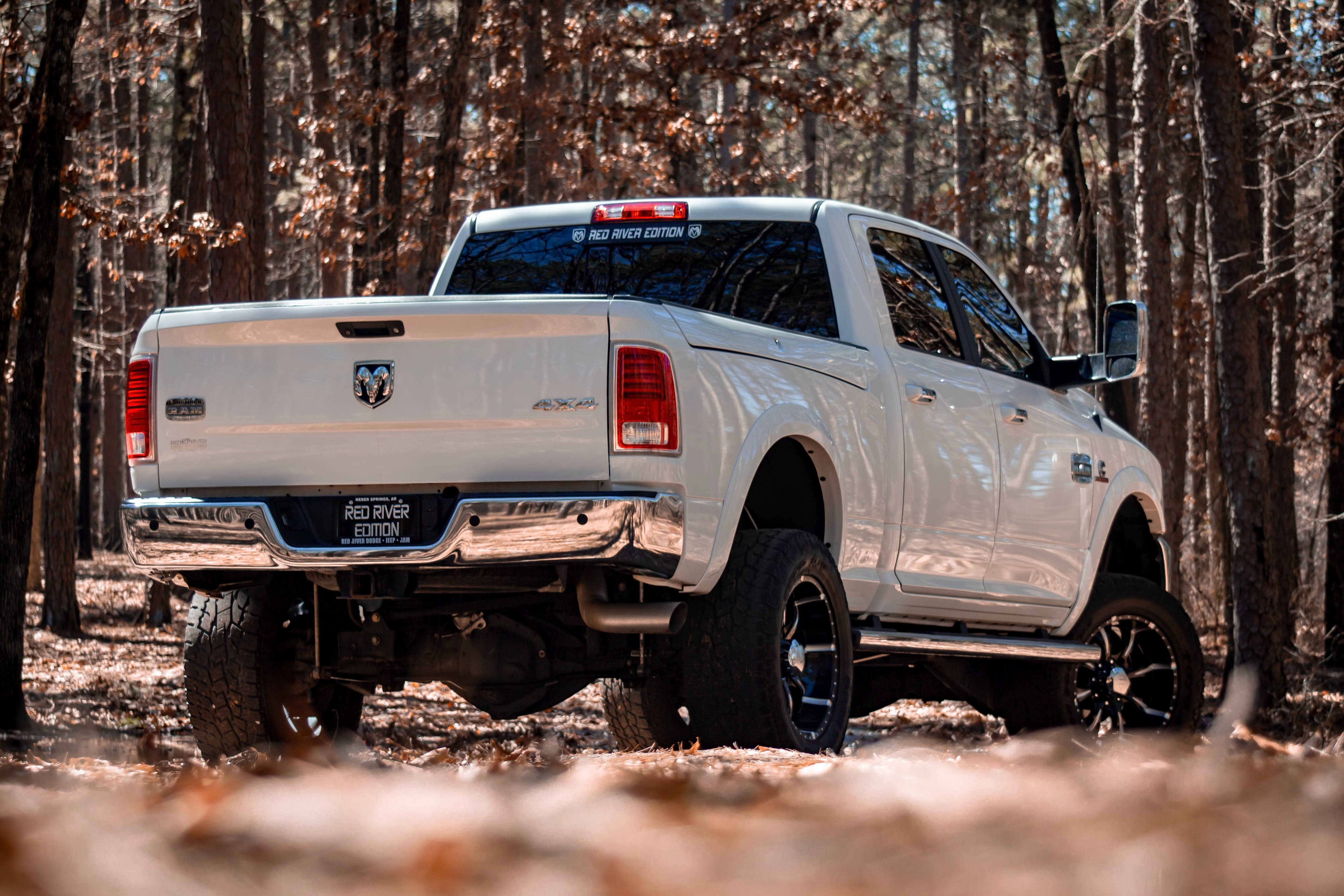Tire Maintenance & Safety
Understanding Wheel Offset: A Guide to Fitment, Performance & Safety

Free shipping
Best price guarantee
Special pricing
Financing with Resolve
Easy returns
Tire Maintenance & Safety


Wheel offset plays a critical role in how your vehicle looks and performs, yet many car owners overlook this crucial measurement when shopping for new wheels. The wrong offset can transform a simple wheel upgrade into an expensive mistake that affects everything from handling to safety.
Modern vehicles rely on precise wheel positioning to maintain proper suspension geometry and brake clearance. Whether you drive a compact sedan or a lifted truck, understanding offset helps you make informed decisions about wheel modifications.
This measurement determines where your wheel sits relative to the suspension components and fender wells. Small changes in offset can have big impacts on your vehicle's behavior, appearance, and even its legal compliance on public roads.

Wheel offset is the distance (measured in millimeters) from the centerline of the wheel to the hub mounting surface. This measurement determines how your wheels sit in relation to your vehicle's suspension and body. Think of it as the invisible force that pushes your wheels inward or outward from their mounting point.
Understanding wheel offset helps ensure proper fitment and avoid costly mistakes. The mounting surface location affects your vehicle's track width, handling characteristics, and clearance. When the mounting surface sits exactly at the wheel's centerline, you have zero offset. Move that surface toward the street side of the wheel, and you create positive offset. Position it toward the back of the wheel, and you have negative offset.
Each type of offset serves specific purposes and suits different vehicle applications. Factory engineers carefully select offset specifications to balance handling, clearance, and aesthetics. Changing these specifications without understanding the consequences can lead to rubbing tires, compromised handling, or damaged suspension components. The offset number stamped on your wheel — typically shown as "ET" followed by a value — tells you exactly where that mounting surface sits in relation to the wheel's centerline.
Zero offset is characterized by the wheel's hub mounting surface being perfectly aligned with its centerline. This configuration ensures balanced spacing between the inner and outer wheel edges, maintaining a symmetrical stance. It's often employed in older vehicles and performance models where stability and equal weight distribution are key priorities.
Positive offset occurs when the hub mounting surface is positioned toward the outer side of the wheel. This setup is prevalent in modern vehicles, particularly those with front-wheel drive and newer rear-wheel drive designs. By aligning the wheels closer to the suspension, positive offset offers a streamlined appearance and helps maintain clearance. Typical values range from +15mm to +50mm, ensuring compatibility with a variety of vehicle designs.
Negative offset pushes the hub mounting surface inside the wheel, creating the sought-after "deep dish" look. This style is popular among lifted trucks and off-road vehicles, where a wider wheel stance enhances both aesthetic appeal and stability. By extending the wheels outward, negative offset provides a more pronounced road presence and can improve handling characteristics on challenging terrain.

The offset of a wheel plays a crucial role in determining how your vehicle navigates and grips the road. It influences the scrub radius, which is the gap between the tire's centerline and the pivot point of the suspension. This adjustment is key for maintaining steering accuracy and overall vehicle balance. A suitable scrub radius contributes to consistent handling and reduces unnecessary strain on steering components.
Offset defines the distance between the wheel and nearby elements within the wheel well. Excessive positive offset may push the wheel too far inward, leading to potential contact with suspension parts or the inner fender. Such interference can cause persistent rubbing sounds and eventual wear to both tires and suspension components. Selecting the appropriate offset ensures sufficient space, preventing these issues when navigating corners or driving over uneven surfaces.
An offset that isn’t aligned with your vehicle's design can interfere with braking systems. Wheels placed too close might come into contact with brake calipers, affecting braking efficiency and accelerating wear. Moreover, a negative offset can impose additional loads on wheel bearings and suspension, hastening their deterioration. By opting for a well-matched offset, you maintain harmony within the braking and suspension assemblies, ensuring they function as intended.
Changes in offset can alter the dynamics of steering responsiveness. Proper offset alignment keeps steering elements in sync, supporting responsive feedback and balanced steering effort. Incorrect offset adjustments can lead to inconsistent steering response or increased kickback when traversing rough terrain. Adhering to recommended offset specifications helps preserve the intended driving dynamics, making your vehicle more predictable and enjoyable to handle.
Deciphering wheel offset measurements is a fundamental step for vehicle owners planning to change or upgrade their wheels. Offset values, expressed in millimeters, dictate how far the wheel will sit from the vehicle’s chassis, influencing both the vehicle's stance and driving characteristics.
Offset values come with either a positive or negative indicator, which reveals the wheel's placement. A positive offset, shown with a "+" (e.g., +35mm), positions the hub closer to the wheel's outer edge, fitting snugly within the wheel well—typical in modern vehicles. A negative offset, indicated with a "-" (e.g., -12mm), pulls the wheel outward, enhancing the vehicle's stance for a broader appearance. A zero offset, often marked as "0" or "ET0," places the hub equidistant from both the inner and outer wheel edges, maintaining a neutral alignment.
Offset and backspacing serve as two distinct measures that together inform wheel fitment. Backspacing, measured in inches, calculates how much space exists between the wheel's inner edge and the mounting surface. Unlike offset, which is purely about positioning, backspacing considers the full width of the wheel, ensuring the wheel clears suspension components. By using a wheel offset calculator, you can convert between these measurements easily, providing a comprehensive view of how different wheel setups will affect your vehicle’s handling and appearance.

Passenger cars and sedans usually favor positive offset wheels, typically ranging from +35mm to +45mm. This configuration is key for ensuring a balance between efficient steering response and optimized fuel consumption. Given the confined space in wheel wells, selecting a suitable offset is vital to prevent any contact with suspension components or the fender. The well-chosen offset helps maintain the vehicle's aerodynamic shape and handling dynamics.
Trucks and SUVs present a diverse range of offset requirements. Stock configurations often feature a modest positive offset, generally between +20mm and +30mm, to accommodate larger wheel and tire setups while ensuring proper clearance. When modifications like lift kits are added, a negative offset might become necessary. This change creates the necessary room for larger tires, preventing them from rubbing against the wheel arches or suspension parts. It's crucial to consider the vehicle's load capacity, ensuring that the wheels can support the demands of towing or carrying heavy loads when opting for aftermarket options.
Performance vehicles often require specific offsets to enhance their cornering abilities. These setups may involve different offsets for the front and rear wheels, known as staggered configurations. This variation in track width is crucial for maximizing stability and grip during high-speed maneuvers. The tailored offsets ensure the vehicle remains agile and responsive, catering to the demands of both street and track driving environments.
Incorrect wheel offset can lead to a host of issues that affect both vehicle performance and safety. Whether the offset is too positive or negative, these misalignments can create significant challenges for drivers.
A wheel with excessive positive offset can lead to inadequate clearance within the wheel well. This misalignment increases the risk of the tire making contact with suspension components, especially under load or during tight maneuvers. Such contact not only causes premature tire wear but can also jeopardize the integrity of the suspension system. Additionally, excessive positive offset may result in the wheel coming too close to braking components, potentially affecting brake performance. The altered positioning can also impact vehicle dynamics, leading to a decrease in overall handling precision and driver confidence.
Negative offset offers a distinct appearance but can also introduce complications. Extending the wheels outward increases the potential for steering instability, particularly on uneven surfaces. This offset configuration places extra demands on wheel bearings and suspension parts, accelerating their wear and leading to potential mechanical failures. Furthermore, wheels that extend beyond the vehicle's body can affect its aerodynamic profile and may not comply with some regional regulations focused on road safety. These protruding tires not only alter vehicle aesthetics but can also pose legal challenges in areas with strict fender laws.
Selecting the appropriate wheel offset requires a comprehensive evaluation of your vehicle's current wheel configuration. Start by examining your wheels for offset markings, typically stamped as "ET" followed by a number. This step is essential for ensuring compatibility with potential new wheels. Utilize a wheel offset calculator to explore how different options might affect your setup, providing a clear comparison of old and new specifications. When changing wheel dimensions, consider the impact on tire size to maintain the balance between performance and fit. Before finalizing any purchase, measure the space within your wheel wells to confirm that new wheels will fit without causing any interference.

Offset calculators and charts are crucial tools for assessing potential changes in wheel fitment. By entering your current and desired wheel specifications, these tools provide a visual depiction of how new wheels will sit on your vehicle. This visualization helps identify potential clearance issues and ensures that the new setup aligns with your vehicle's design. Carefully review these visual representations to ensure that changes in offset will not lead to contact with suspension or body parts, safeguarding against potential fitment problems. Leveraging these resources allows for informed decision-making when selecting wheels that meet both aesthetic and functional requirements.
Engaging with wheel fitment specialists can be invaluable, especially when navigating complex offset decisions. These experts possess a deep understanding of vehicle-specific requirements and can recommend wheels that enhance both performance and style. Providing complete details about your vehicle's year, make, and model enables specialists to tailor their advice to your specific needs. Discuss any modifications that might influence fitment, such as lift kits or altered suspension setups. Whether your focus is on daily driving comfort, off-road capability, or performance enhancements, specialists can guide you in choosing offsets that align with your vehicle's intended use.
Conduct thorough research to ensure your wheel offset choices align with your vehicle's design and needs. Delve into the manufacturer's guidelines, which outline the recommended wheel specifications for optimal performance. Explore community forums and user reviews to gain insights from drivers who have similar vehicle setups. Understanding how various tire rim designs interact with offset is crucial, as they can significantly influence your vehicle's appearance and drivability. Plan for any future upgrades or modifications, like lifting or tuning, as these can affect the ideal wheel offset for your setup.
When it comes to fitting new wheels, precision is key. Carefully evaluate the wheel's fit by observing clearance at full steering lock and during suspension compression. Use wheel spacers judiciously if minor adjustments are needed to achieve the desired stance. Ensure that aftermarket wheels are installed with the correct lug nut engagement to avoid potential safety risks. After installation, check that the changes haven't affected your speedometer's accuracy, as variations in wheel size can lead to incorrect speed readings.
Compliance with legal and safety standards is essential when modifying your vehicle's wheel offset. Some jurisdictions have specific rules about tire protrusion, and exceeding these can result in penalties or compliance issues. Be aware that modifying offset beyond recommended limits may impact your vehicle's warranty, leaving you liable for related issues. Additionally, improper offset could affect insurance coverage, especially if it contributes to an incident. Always prioritize adherence to safety standards while achieving the desired aesthetic for your vehicle.
Understanding wheel offset empowers you to make informed decisions that enhance both your vehicle's performance and appearance. The right offset ensures proper fitment, maintains safe handling characteristics, and helps you achieve the look you want without compromising functionality. When you're ready to upgrade your wheels and tires, we make it easy to shop for tires online and find the best deals that match your specific offset requirements and driving needs.
Search By